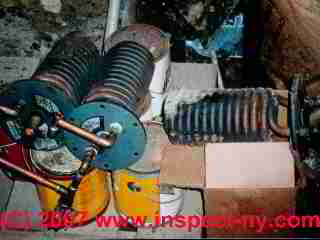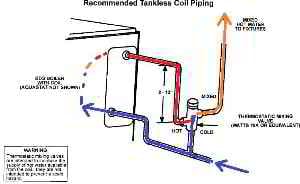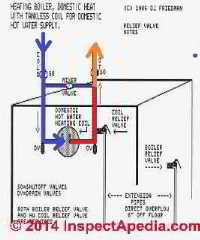 How to install a Tankless Coil for Hot Water Heating
How to install a Tankless Coil for Hot Water Heating
Tankless coil installation procedure
- POST a QUESTION or COMMENT about installing or replacing a tankless coil for hot water supply
Tankless heater coil installation on a boiler: this article describes the steps in installing or replacing a tankless coil on a hot water (hydronic) or steam boiler.
Tankless coils are used to provide domestic hot water by heating building water as it passes through a heat-exchanging coil immersed in the heating boiler's hot water contents.
InspectAPedia tolerates no conflicts of interest. We have no relationship with advertisers, products, or services discussed at this website.
- Daniel Friedman, Publisher/Editor/Author - See WHO ARE WE?
Tankless Heater Coil Installation Procedures
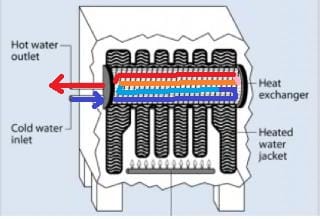 at page top we include a sketch showing the typical installation of a tankless coil on a residential heating boiler. Notice in the page top sketch that a mixing valve or anti-scald valve has been installed between the cold inlet to the tankless coil and the hot outlet pipe from that device.
at page top we include a sketch showing the typical installation of a tankless coil on a residential heating boiler. Notice in the page top sketch that a mixing valve or anti-scald valve has been installed between the cold inlet to the tankless coil and the hot outlet pipe from that device.
[Click to enlarge any image]
At left we've adapted a U.S. Energy.gov sketch from a confusing article that mixes up TANKLESS COILS (boiler-mounted devices that we discuss in this article),
INDIRECT FIRED WATER HEATERS (a tank of hot water heated by a heat exchanger inside the tank that itself is heated by water from the heating boiler),
and TANKLESS WATER HEATERS (stand-alone, instant, tankless water heaters). - U.S.DOE (2014)
As you can see, a tankless coil used for making hot water is a heat exchanger that is inserted into the heating boiler's very hot water. As cold water flows through the inside of the tankless coil it is heated up, leaving the coil hot.
On some heating boiler designs the tankless mounting plate is round (photo below).
When I find a pile of tankless coils like this I know the building occupants have not been having a good time in the shower. On other tankless heater coil designs the coil mounting plate may be round as we illustrate in M.C.'s photo later in this article. And tankless coils may mount on any of the boiler sides or even on its top, depending on the boiler's design.
On steam boilers a tankless coil may also be mounted but will always be below the boiler's water level.
Step by Step Tankless Coil Installation Procedure
Watch out: when installing a tankless coil to follow the manufacturer's instructions about handling and sealing the boiler-to-coil gasket (some may specify no sealant is used), and about uniform torquing of the coil faceplate mounting bolts.
- Start the installation of a tankless coil heater by doing the unusual: read the instructions from the boiler manufacturer.
We provide some example instructions just below, based on the Crown BDS Series oil fired hot water boilers. But installation details from your manufacturer may vary. The following is adapted and excerpted from the Crown Boiler advice here are typical steps in tankless coil installation: - Unpack the tankless coil and gasket. Be sure all parts are in good order. If there are tie wires holding coil sections together (see Reader Question - below), remove these.
- Drain the boiler and heating system [and let the system cool down to a safe working temperature]
- Remove the boiler jacket cover panels to give access to the tankless coil mount location
Sketch at left adapted from Crown Boiler's BDS boiler installation instructions. Contact information for the Crown Boiler Company is given below.
- Remove the screws or nuts holding the coil mount location cover plate (red & gray rectangle in our sketch) in place, along with the gasket, and discard these. Typically you will see a round or rectangular plate where the tankless coil will mount.
- Place the tankless coil gasket (orange in sketch) over the coil and up against the inside surface of the coil's mounting faceplate (green and gray in sketch). [Notice that the manufacturer does not mention any sealant, just the gasket; be sure all mounting surfaces and the gasket are clean.]
- Watch out: if an arrow is present on the coil faceplate be sure it's pointing "up" (or as directed) and that the word "TOP" (if present) is indeed at the top of the coil.
- Replace the cap screws or nuts (depending on the coil mounting hardware type), and tighten evenly and snug. (blue in sketch)
Watch out: do not over-torque the coil mounting bolts, screws or nuts. If you snap one off in the boiler there will be hell to pay getting out the broken-off piece. - Watch Out: the coil for signs of TANKLESS COIL / HOT WATER COIL LEAKS after it has been installed and after the boiler has reached normal operating pressure and temperature.
Small leaks at the coil may show up only a an accumulation of mineral deposits, as boiler temperatures evaporate small leaks: you won't see water on the floor.
At above left we illustrate the typical piping arrangement into and out of a tankless coil water heating system. Cold water is piped to an inlet marked "COLD" and building hot water supply piping is connected to the tankless coil outlet marked "HOT".
[Click to enlarge any image]
This tankless coil piping example from Crown Boilers indicates the use of a mixing valve or anti-scald valve right at the heating boiler. The company includes an interesting warning reading as follows [Quoting - Crown BDS Installation Manual]
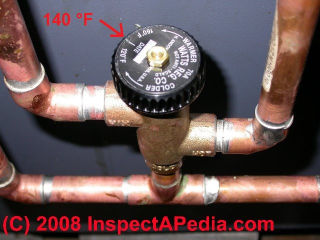 WARNING: Thermostatic mixing valves are intended to increase the supply of hot water available from the coil. They are not intended to prevent a scald hazard.
WARNING: Thermostatic mixing valves are intended to increase the supply of hot water available from the coil. They are not intended to prevent a scald hazard.
Really? I speculate that the company's lawyers got a hold of this one - nobody wants to be named in a scald lawsuit. Some manufacturers may hold the view that anti-scald devices should be installed at each fixture, at the point of use.
Our photo shows a typical mixing valve produced by Watts Regulator Co. The mixing valve manufacturer's installation instructions for these devices include similar warnings.
Also be sure to follow the mixing valve manufacturer's installation instructions. For example Watts recommends:
To prolong the life of the Model LF1170-M2 or LFL1170-M2 valve [not shown here], it is recommended that it be trapped as shown ...: i.e. the hot water inlet to the LF1170-M2 valve should be 8" – 12" (200 – 305mm) below the hot water supply feed. - "Instructions Series LF1170 and LFL1170 Hot Water Temperature Control Valves", Watts Regulator Co. (2013)
See details about the piping, intallation specifications and warnings for tempering or mixing valve installations
at ANTI SCALD VALVES
and
at ANTI SCALD VALVE PROTECTION, Best Practices.
Tankless Coil Installation Resources
- Crown Boiler Manual, BDS Series Oil-Fired Hot Water Boilers, Installation Instructions, Models Models: BDS-080 BDS-092 BDS-119 BDS-150 BDS-178 BDS-147 BDS-209 BDS-236 Manual, GS-080 Crown BDS-23 Crown Boiler Company, 3633 I Street Philadelphia, PA 19134 USA BDS 12-99, Crown Boiler Co. P.O. Box 14818, 3633 I Street Philadelphia, PA 19134 (215) 535-8900, Website: http://www.crownboiler.com, retrieved 2/26/2014, original source: http://www.crownboiler.com/manuals/content/ All_Models/BDS%20Series%20%28all%20models%29.pdf - dead link, retrieved 2020/02/15 original source: http://www.velocityboilerworks.com/documents/BDS-Series-all-models.pdf
- [1] Bosch Tankless Water Heaters - http://www.boschhotwater.com/
- [1a] Bosch, "Instrucciones de instalacion y manejo, Calentador de agua instantaneo, Confort / Confort S 6BP / 6BP n 10BP / 10BP N 13BP / 13BP N" Robert Bosch, S. de R.L. de C.V., Calle Robert Bosch 405, Zona Industrial, Toluca, Edo de Mexico CP 50070, website: www.bosch.com.mx, Tel: 800-11-26724 (2010)
- [2] Chromolite Tankless Water Heaters
- [10] U.S. Department of Energy on Tankless Water Heaters - http://apps1.eere.energy.gov/consumer/your_home/water_heating/index.cfm/mytopic=12820
- [11] TANKLESS or DEMAND TYPE WATER HEATERS [PDF] U.S. Department of Energy, retrieved 10/14/2012, original source: http://energy.gov/energysaver/articles/tankless-or-demand-type-water-heaters [Copy on file as Tankless_Water Heaters_DOE.pdf] retrived anew 2/25/2014
...
Reader Comments, Questions & Answers About The Article Above
Below you will find questions and answers previously posted on this page at its page bottom reader comment box.
Reader Q&A - also see RECOMMENDED ARTICLES & FAQs
Moderator reply: how to propery abandon a tankless coil on a hydronic or steam heating boiler
Loven
If the tankless coil input and outlet pipe openings are no longer connected to the domestic water supply (cold in, hot out) then they have no effect on the boiler whatsoever.
Some installers take the extra step of capping off the two openings so that should the coil actually develop a leak along the coil itself boiler water cannot leak out through the tankless coil inlet and outlet - the boiler won't lose water.
Regarding your final question: there is no way for pressure to expand out of the domestic water supply into the coil because you have disconnected the coil pipes from the building domestic water piping.
If instead you left the domestic water cold in and hot out pipes connected to the boiler, presumably shut off by control valves on building water piping, that's a less reliable abandonment procedure since we cannot know that in the future those valves might leak or that someone might open them once again.
That's why "abandoning" a tankless coil should mean disconnecting it from domestic hot water and cold water piping in and out of the coil and best-practice, capping off those openings or sealing them with a pipe plug.
On 2020-02-15 by loven - can closing off an un-used tankless coil cause a boiler to explode?
I understand how an in use leaking tankless coil would cause the boiler water pressure to build due to the domestic hot water being substantially higher.
As far as an out of use tankless coil/ empty or mostly empty of water but then capped completely sealed and assuming there were no leaks in the coils, and since being sealed with no way for any pressure to expand out into the domestic supply could that not cause a blow out of the coil itself or even it did would it be contained inside the boiler thus causing no safety issues?
On 2020-02-14 - by (mod) -
No Loven.
The two pipes of a tankless coil used on a conventional heating boiler, such as we show on this page were originally connected to a cold water supply line in and a hot water supply line out of the coil.
The water that ran through those lines was physically separate from the boiler's own internal water. Disconnecting and then closing off those pipes would have no effect on the internal pressure in a hydronic boiler.
Watch out: however: if a tankless coil is actually leaking then the cold water supplied to the coil, because it's often at pressures above normal boiler operating pressures, could leak into the boiler and increase its pressure abnormally.
If we have a double fault of a tankless coil leaking INTO the boiler AND a defective boiler temperature/pressure relief valve (that ought to be opening to relieve that abnormal pressure) then a dangerous BLEVE explosion could occur.
Search InspectApedia.com for BLEVE EXPLOSIONS and for TANKLESS COIL LEAKS to read details.
On 2020-02-14 by loven
In regards to plugging the two pipes exiting the old unused tankless coil; could plugging cause a pressure build up in the coil potentially leading to a BIG boom??
On 2019-11-20 - by (mod) - distance a Honeywell themostatic mixing valve installation away from a coil
Great question, Anon.
In theory a mixing valve can be anywhere, though the effects of its location can be significant on the hot water temperature actually delivered right at the plumbing fixture.
For example, it's most-common to put a mixing valve (anti-scald valve) right at the tankless coil on a heating boiler - inches away; that's convenient and easy.
But in some buildings there is no mixing valve at the hot water source (that might be a tankless coil or an indirect water heater or even a simple water heater - all being run really hot);
Instead the builder may install an anti-scald device right at each plumbing fixture that can be used to provide hot water. So those distances can be 10 to hundreds of feet from the actual water heater.
This second approach is often used in large buildings such as apartment buildings or hotels in which there is a single common water heater; such buildings may install a circulating system so that there is always hot water available everywhere, and then the plumber protects each occupant from being scalded by installing anti-scald devices right at each fixture.
On 2019-11-20 by Anonymous
What is the minimum and maximum distance a Honeywell themostatic mixing valve installation away from a coil
On 2019-04-06 - by (mod) - should i change the mixing valve when replacing the coil?
No need if it's working ok.
However if your tankless coil was replaced due to mineral scale clogging or corrosion, double check (measure temperatures) that the mixing valve (anti-scald valve) is working properly, regulating temperature, and not obstructing the water flow.
On 2019-04-03 by Vito
should i change the mixing valve with the new coil, i changed the valve last year.
On 2018-01-01 - by (mod) -
Anthony,
It's not necessary to plug the abandoned tankless coil for the heating boiler to operate normally.
However to ensure against the possible leak through the coil that would allow boiler water to leak into the coil and then exit the boiler through the coil openings, if it were my system I would prefer to install plugs on the two ends where the cold water and the hot water connected. It's not absolutely essential nor is it urgent but in my view it's a good idea
On 2018-01-01 by anthonybozz
My previous comment was stated incorrectly. The newly installed hot water tank is heated on a separate zone rather than by the coil in my boiler; the hot and cold water pipes to the coil have been removed, and the coil has not been removed from the boiler. Is it necessary to plug the two fittings on the coil? Is it safe to operate the boiler without the plugs installed?
I recently had a separate hot water tank installed to supply hot water from the coil in my boiler; the installer did not remove the existing coil from the boiler; (I have a Peerless cast iron boiler, which is about 25 years young.) Is it necessary to plug the two fittings on the coil? Is it safe to operate the boiler without the plugs installed?
On 2017-12-30 - by (mod) - best type of gasket to use to seal the hot water coil to the boiler
Rubber or high temperature silicone gasket
On 2017-12-29 by pete
whats the best type of gasket to use to seal the hot water coil to the boiler
Reader Question: do I leave-on or remove tie wires found on the tankless coil before I install it on my heating boiler?
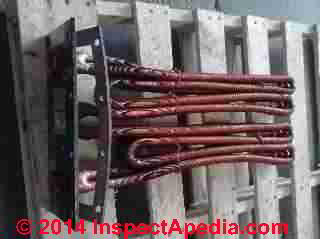 I am installing two DHW coils on a Crown Series 24 steam boiler (sectional, 6-sections). The coils came tied with bailing wire. The bailing wire is not copper, it does however seem to be in logical areas to keep the coils together and ridged. Is this done just for shipping?
I am installing two DHW coils on a Crown Series 24 steam boiler (sectional, 6-sections). The coils came tied with bailing wire. The bailing wire is not copper, it does however seem to be in logical areas to keep the coils together and ridged. Is this done just for shipping?
Should I remove the bailing wire, or does it stay on the coils helping hold them together?
This ... is of the DHW cools for my Crown boiler. This is just one of them, and shows the bailing wire in question. My gut says remove it, but ? - M.C. 2/24/2014
Reply:
Before we saw the photo we were not sure of the right answer. But from the photo I'd certainly expect that was junk wire intended to be removed. These are "tie wires" intended to prevent the coil sections from damage due to flopping around during shipping. I'm also a little worried about tankless coils showing up exposed - it's the fins and tubing that transfer heat from boiler water to water in the coil - I wouldn't want the coils to be bent, dinged, or crushed. Is this new equipment?
Don't leave these wires t in place - you would risk unwanted corrosion on the coil itself once it's installed, as well as risking dropping junk into the boiler interior as the wire rusts and falls off.
But if on removal the coils seem to flop too loosely, I'd look carefully at how they'll be suspended in the boiler interior - and let me know if that looks odd and we'll pursue it with Crown.
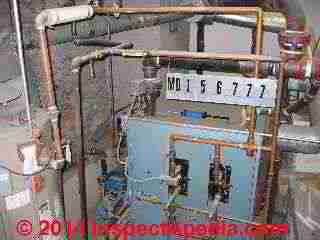 For example if the coil tubing were so flexible that it fell inside the boiler ending in contact with a hot spot that'd not be very attractive.
For example if the coil tubing were so flexible that it fell inside the boiler ending in contact with a hot spot that'd not be very attractive.
Also take a look at MIXING / ANTI-SCALD VALVES - you may want to install a mixing valve if one is not already provided, both to avoid a scalding risk and to permit more efficient use of the coil.
Our photo (left) illustrates a heating boiler with two rectangular tankless coils installed. [Click to enlarge any image]
I would not leave a wire of a different metal wrapped around a coil to be inserted into the boiler - without first checking with the manufacturer. I can imagine two very different situations:
A different metal wire wrapped for stability during shipping might actually cause corrosion by galvanic action when the coil is inserted into the boiler - so should be removed
On the other hand
A manufacturer *might* have wrapped a different metal wire around the coil tubing as a sacrificial anode much as we see inserted into a domestic water heater tank.
So what we need is to know the manufacturer of the coil, or if there is none, we'd contact the boiler manufacturer - Crown - to find out what's up.
Are there any installation instructions with boiler? If not I'd download those as they may address this question. Here is contact information for your boiler manufacturer:
Crown Boiler Co.
P.O. Box 14818
3633 I Street
Philadelphia, PA 19134
(215) 535-8900
Website: http://www.crownboiler.com
Reader follow-up:
You are correct this boiler has two coils. they are not wired to each other, they came shipped separately and with adequate protection. The inlet is standard pipe thread, and in the mounting plate the inlet spits off to three separate finned copper tubes that each go into the boiler and make a few passes then come back to a fitting that runs them all back to one tube.
On the three tubes that zigzag back and forth on their several passes they are tied together with bailing wire. Would the bailing wire just rust away eventually, meaning that it is there just for shipping, and should be removed?
I confirmed with [the boiler manufacturer] Crown that they should be removed.
...
Continue reading at TANKLESS COIL / HOT WATER COIL LEAKS or select a topic from the closely-related articles below, or see the complete ARTICLE INDEX.
Or see these
Recommended Articles
- ANTI SCALD VALVES
- TANKLESS COILS - home
- AQUASTAT CONTROL FUNCTIONS
- BODY OVERHEATING HAZARDS
- CLOGGED PIPES / TANKLESS COIL DE-SCALE
- HOT WATER ANTI-SCALD REGULATIONS
- MIXING / ANTI-SCALD VALVES - brands, models, sources
- TANKLESS COIL ABANDONMENT or CONVERSION
- TANKLESS COIL HOT WATER HEATER TEMPERATURE CONTROL
- TANKLESS COIL HOT WATER INCREASE
- TANKLESS COIL INSTALLATION PROCEDURE
- TANKLESS COIL INTERNAL LEAKS INTO the BOILER
- TANKLESS COIL / HOT WATER COIL LEAKS
- TANKLESS WATER HEATERS - home
Suggested citation for this web page
TANKLESS COIL INSTALLATION PROCEDURE at InspectApedia.com - online encyclopedia of building & environmental inspection, testing, diagnosis, repair, & problem prevention advice.
Or see this
INDEX to RELATED ARTICLES: ARTICLE INDEX to WATER HEATERS
Or use the SEARCH BOX found below to Ask a Question or Search InspectApedia
Ask a Question or Search InspectApedia
Try the search box just below, or if you prefer, post a question or comment in the Comments box below and we will respond promptly.
Search the InspectApedia website
Note: appearance of your Comment below may be delayed: if your comment contains an image, photograph, web link, or text that looks to the software as if it might be a web link, your posting will appear after it has been approved by a moderator. Apologies for the delay.
Only one image can be added per comment but you can post as many comments, and therefore images, as you like.
You will not receive a notification when a response to your question has been posted.
Please bookmark this page to make it easy for you to check back for our response.
IF above you see "Comment Form is loading comments..." then COMMENT BOX - countable.ca / bawkbox.com IS NOT WORKING.
In any case you are welcome to send an email directly to us at InspectApedia.com at editor@inspectApedia.com
We'll reply to you directly. Please help us help you by noting, in your email, the URL of the InspectApedia page where you wanted to comment.
Citations & References
In addition to any citations in the article above, a full list is available on request.
- In addition to citations & references found in this article, see the research citations given at the end of the related articles found at our suggested
CONTINUE READING or RECOMMENDED ARTICLES.
- Carson, Dunlop & Associates Ltd., 120 Carlton Street Suite 407, Toronto ON M5A 4K2. Tel: (416) 964-9415 1-800-268-7070 Email: info@carsondunlop.com. Alan Carson is a past president of ASHI, the American Society of Home Inspectors.
Thanks to Alan Carson and Bob Dunlop, for permission for InspectAPedia to use text excerpts from The HOME REFERENCE BOOK - the Encyclopedia of Homes and to use illustrations from The ILLUSTRATED HOME .
Carson Dunlop Associates provides extensive home inspection education and report writing material. In gratitude we provide links to tsome Carson Dunlop Associates products and services.


